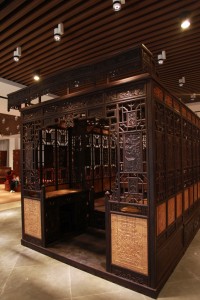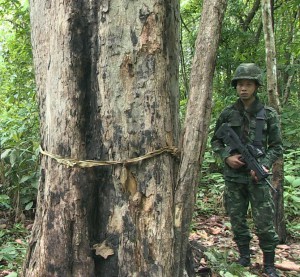The Siamese rosewood craze: for whom the bell tolls?


In a glamorous hongmu showroom in Shanghai, streams of the bustling crowds slowed down to appreciate sets of exquisitely carved Siamese rosewood furniture. What attracted the potential hongmu consumers and investors, beyond the fine and delicate craftsmanship, are the hefty price tags that any ordinary workingmen could only afford to look at. Few of the audience had, for a second, thought of the Siamese rosewood trees that had been growing for hundreds of years along the Mekong River before being cut down to become a piece of furniture.

Siamese rosewood bed (c) EIA
Siamese rosewood (Dalbergia cochinchinesis) is a species that has lived longer than human beings on this planet earth. Yet recent decades of rampant demand for high-end furniture are driving the species to the brink of extinction. The dead-end situation that Siamese rosewood is now facing goes beyond merely an environmental or ecological problem – it is a bloody corrupt war with cruel costs, such as human lives, as uncovered by EIA’s recent report Routes of Extinction.
From Thailand to Cambodia, Laos to Vietnam and Singapore to mainland China, EIA’s investigators posed as buyers to meet with scores of traders to document the complex trans-national supply chain of the hongmu business: loggers were lured into the remote forest with cash payments, even drugs, and many have lost their lives during the exchanges of gunfire with Thai forest rangers; a relative of high-ranking Laotian military official took batches of Chinese timber traders into the military yard to shop for illegal hongmu woods which were confiscated by the military; a local Vietnam gangster explained how he had paid off border officials to facilitate his hongmu smuggling operation to China, while stacking bundles of cash in a bag; in the ports of Hong Kong and Shenzhen, a well-connected logistics agent claimed to have connections to prepare papers to legally bring illegally sourced Siamese rosewood into China; in Fujian, shrewd businessmen have already shifted their bets on replacement hongmu species with funds gathered from Siamese rosewood investment vehicles.
Siamese rosewood, known as Lao hongmu in the Beijing region, is one of the most sought-after raw materials in the hongmu industry in China. Despite it being protected in all its range states and its international trade being restricted by an international convention, EIA found that as recently as this March, many Chinese businessmen were still illegally sourcing Siamese rosewood raw materials in Laos, Thailand, Vietnam and Cambodia. These traders wasted no time in taking these raw materials to China, often via Hong Kong, through bribery and smuggling.

Guarding Thailand’s largest remaining rosewood tree (c) Roger Arnold
The Mekong region has historically been a supply base for China’s hongmu industry and has also been most affected by the hongmu resurgence of the past decade. Since 2000, nearly half of the hongmu China has imported is from the Mekong region. For decades, Chinese and Vietnamese traders have scoured the region for precious remaining Pterocarpus and Dalbergia species. The commercial extinction of higher grade hongmu species such as Dalbergia odorifera (known as Huanghuali) due to excessive harvesting for China’s hongmu sector has resulted in Siamese rosewood becoming one of the most prized hongmu species.
But in 2013 and 2014, the timber traders EIA met in Laos and Vietnam all said that Siamese rosewood’s golden age is now a thing of the past – it is increasingly difficult to source Siamese rosewood raw materials, hence most have already moved on trading other species such as Burmese rosewood and Padauk. According to these traders, supply of these two species would last no more than three to five years.
The surging demand for high-end Ming and Qing dynasty reproduction furniture, together with the under-regulated expansion of the hongmu industry, threaten to wipe out some of the mostly iconic species revered in traditional hongmu culture. However, the current hongmu craze in China does little to revive the Chinese cultural heritage. On the contrary, under the cover of cultural tradition, most hongmu businesses are in fact driven by speculation and hype, undermining the resource supply on which the traditional hongmu culture depends.
The Redwood Committee, China’s official national hongmu trade association, has stated in its recent hongmu market report that “in 2013, the hongmu market has seen an evident growth in investment-led consumption … hongmu has become another hot choice for investment after art works such as paintings and calligraphies.”
In reality, it is indeed a vicious circle as the scarcer a hongmu species becomes, the more prices shoot up and the more demanded it becomes by the affluent class as an inflation-prove investment. Such demand again drives searches for the species in the range states. In Laos, a timber trader from Fujian told EIA investigators earlier this year that “these trees are more valuable than properties as you may build houses but these hundred years old trees will be no more.”
In China, critical reflection of the contemporary hongmu industry is rare but has started to emerge. For instance, Zhou Mo, an expert of China Cultural Relics Restoration Commission, pointed out in a national forestry seminar this March: “For nearly 40 years, no scientific, reasonable and civilized path has ever been found for the development of hongmu and hongmu furniture in China. Hongmu furniture manufacturing is still engrossed in rare materials and high prices, pursuing the large size, complicated carving and decoration, fine polishing or novel shapes. From this furniture, we are totally incapable of catching sight of the traces of traditional excellent Chinese furniture.”
Supposedly, the main responsibility of protecting Siamese rosewood lies with the range states in the Mekong region. But the weak and corrupted enforcement and ongoing legal and policy contradictions which promote and provide mechanisms for trade in illegal rosewood have encouraged and sustained the illegal hongmu trade.
As the major hongmu consuming country in the world, China has a responsibility too – Chinese consumers and investors have both an obligation and a right to fully understand the hongmu business in order to make rational purchasing options, they need to especially be aware of the negative impact of illegal hongmu trade has on the environment, the rule of law and the human lives.
The Chinese Government has the obligation to establish a clear legal boundary by which illegally logged timber will be excluded from the Chinese market, and at the same time carry out reforms in the hongmu industry to make sure it won’t stimulate demand for endangered species and to put an end to the illegal hongmu trade.
.在上海一家高档红木展示厅内,熙熙攘攘的人流纷纷驻足于一套又一套标着天价的大红酸枝家具前。令红木消费者和投资者们流连和艳羡的,是精美绝伦的技艺以及让普通百姓心惊的标价。他们大都不曾想过,这些用于制作大型家具的大红酸枝,需要在东南亚的热带森林中生长至少几百年。

Siamese rosewood bed (c) EIA
大红酸枝(学名:交趾黄檀,拉丁文:Dalbergia Cochinchinesis)这种比人类历史都要悠久的物种,却在过去几十年内因人类的需求,已经到了物种灭绝的边缘。然而,大红酸枝的绝境,不光是一个生态和环境问题,英国的环保组织环境调查署近日发布的报告揭示,湄公流域以大红酸枝为代表的非法红木贸易的背后,是鲜为人知的血腥和腐败的木材争夺战。
从泰国到柬埔寨,从老挝到越南,从新加坡到香港以至中国内地,环境调查署的调查员伪装成红木买家,同红木供应链上形形色色的人物会面。他们所记录的是:一拨拨深受毒瘾摧残的采伐者,以冰毒为饵被雇前往密林,在与泰国护林员交火丧生;老挝军队高官的亲戚,一次次将中国木材商带入军营,采购被军队查扣的非法红木原料;越南当地的黑社会头目一边将一叠叠现金塞进皮包,一边解释自己已经买通边境官员,保证能将红木通过陆路走私进入中国;在香港、深圳关口,人脉广阔的物流中介通过伪造和贿赂,得以将非法出口的大红酸枝原料合法进入中国;在福建,精明的商人预见到大红酸枝原料的衰竭,开发出几款信托投资产品,将所集资金用于买卖花梨、花枝等替代红木品种。
大红酸枝,在北京地区被称为“老红木”,是目前红木行业最珍稀的原料之一。大红酸枝在所有其原生国都受到法律保护,其跨国贸易受国际公约许可证的严格限制,但环境调查署的调查发现,近至今年3月,大量中国木材企业仍在老挝、泰国、越南和柬埔寨违法收购大红酸枝原料,并不顾国内国际法律限制,通过贿赂、走私等不正当手段将原料出口。
湄公河地区(包括越南、柬埔寨、老挝、泰国和缅甸)历史上一直是中国的红木供应基地,也是受过去十年红木再度流行影响最严重的地区。自2000年以来,中国进口的红木,近一半来自湄公河地区。多年来,中国和越南商人在该地区搜罗剩余的紫檀和黄檀。中国红木产业的强劲需求早已使得降香黄檀(俗称海南黄花梨)等更高级的红木树种遭受商业意义上的灭绝,这使得大红酸枝成为该地区最珍贵的红木品种之一。

Guarding Thailand’s largest remaining rosewood tree (c) Roger Arnold
但在2013和2014年,在老挝和越南的中国木材商纷纷表示,大红酸枝的黄金时代已经过去——大红酸枝的原料越来越难找,他们大部分都转而下注花梨和花枝,他们预计这两个树种的原料生意也将在三五年内完结。
过去十年,中国对高档仿制明清家具及红木艺术品需求的飙升,红木产业不受约束地扩张,使得一些传统红木文化所崇尚的标志性物种濒临灭绝。但是,当下的红木潮绝非对悠久的文化传统的复兴,恰恰相反的是,绝大部分红木生意是以文化传统为掩护的投机和炒作,直接威胁到传统红木文化所依赖的原料来源。
红木官方行会中国红木委在近期发布的红木市场报告中写道:“2013年,红木市场投资性消费明显增长⋯⋯红木已经成为书画之后,社会投资的热点。”现实的确是,当某种红木越是稀缺,其价格就涨得越高,越是成为富裕阶层的现金保值投资品从而形成恶性循环。在老挝,一位福建商人对环境调查署的调查人员说:“这树比房产还值钱,房子还可以再建,这些几百年才长成的树,砍完了就没有了。”
在中国,对当代畸形发展的红木业反思的声音还属罕见。例如,中国文物修复委员会的周默在今年3月的一场的林业研讨会上发言称:“近40年来,中国红木和红木家具的发展并未找到一条科学、合理、文明、理性的路径,还是折冲于木材的稀有、价格的高低,追求硕大的器型、繁琐的雕饰、细腻的磨光或新奇的造形,完全看不到中国传统优秀家具的影子。”
无庸置疑,保护大红酸枝等红木原料的主要责任在于树种生长国——湄公河出产国受腐败影响的执法不力、官商勾结以及持续的法律和政策的自相矛盾,实际上鼓励和维持了非法红木贸易。
但是,作为全球最主要的红木木材消费国,中国消费者和投资者有义务也有权利更为全面地了解红木贸易,尤其是了解非法红木贸易对生态、法制以及人类生命的践踏,从而作出更为理性的消费判断;中国政府有义务建立更为明确的法律,禁止企业进口非法采伐的木材,同时对红木行业进行改革,确保其不在刺激对濒危树种的需求,并全面停止非法木材的交易。
Vicky Lee
贸易和政策分析员